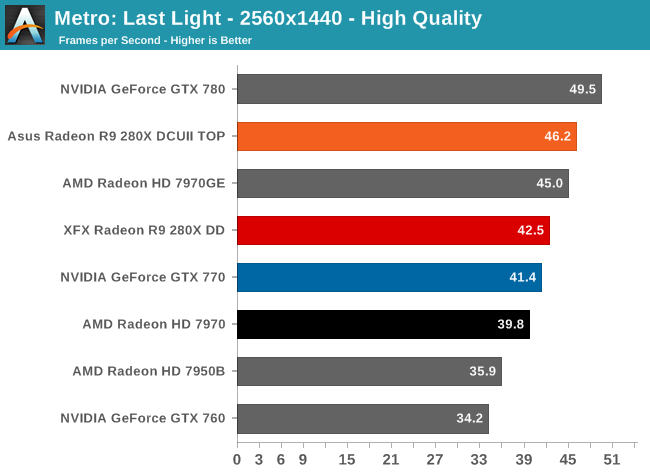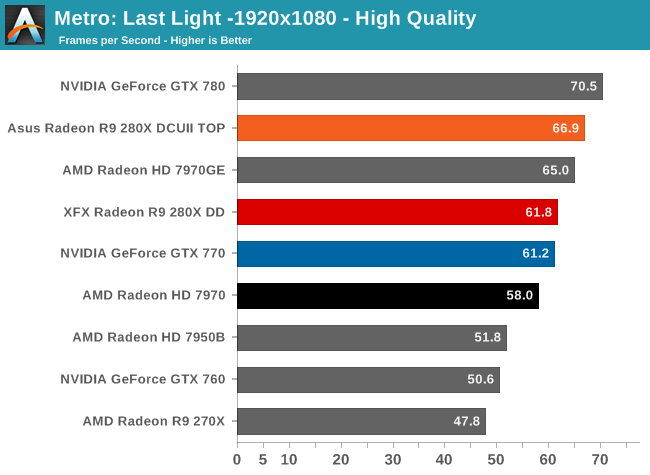The Radeon R9 280X Review: Feat. Asus & XFX - Meet The Radeon 200 Series
by Ryan Smith on October 8, 2013 12:01 AM ESTMetro: Last Light
Kicking off our look at performance is 4A Games’ latest entry in their Metro series of subterranean shooters, Metro: Last Light. The original Metro: 2033 was a graphically punishing game for its time and Metro: Last Light is in its own right too. On the other hand it scales well with resolution and quality settings, so it’s still playable on lower end hardware.



The first benchmark in our revised benchmark suite finds our 280X cards doing well for themselves, and surprisingly not all that far off from the final averages. Setting the baseline here, as we expected the Tahiti based 280X performs in between the original 7970 and 7970 GHz Edition, thanks to the 280X’s use of PowerTune Boost but at lower clockspeeds than the 7970GE. Consequently this isn’t performance we haven’t seen before, but it’s very much worth keeping in mind that the 7970GE was a $400 card while the 280X is a $300 card, so approaching the 7970GE for $100 less is something of a significant price cut for the performance.
As for the immediate competitive comparison, we’ll be paying particular attention to 2560x1440, which should be the sweet spot resolution for this card. At 2560 we can see that the reference clocked 280X doesn’t just hang with the $400 GTX 770 but actually manages to edge it out by just over a frame per second. As a preface we’re going to see these two cards go back and forth throughout our benchmarks, but to be able to directly compete with NVIDIA’s fastest GK104 card for $100 less is a significant accomplishment for AMD.
Finally, let’s quickly talk about the Asus 280X versus the XFX 280X. Asus winning comes as no great shock due to their factory overclock, but now we finally get to see the magnitude of the performance gains from that overclock. At 2560 we’re looking at just shy of a 9% performance gain, which is in excess of both the boost clock overclock and the memory overclock. The specific performance gains will of course depend in the game in question, but this means that the performance gains in at least one instance are being impacted by the base clock overclock, the larger of Asus’s factory overclocks.










151 Comments
View All Comments
HisDivineOrder - Wednesday, October 9, 2013 - link
Well, they did it for the Geforce 7xx series, so they probably had to do it for the new Radeons. That said, it's nice for users to see how little things changed. You know, for the people who didn't pay attention.I agree though it's kinda boring that we're gonna be stuck on the same Radeon series for another 6 months or year. At least nVidia seems vaguely on track with Maxwell, though unless something changes dramatically I think AMD is going to be putting 0 pressure on nVidia to release Maxwell.
Mantle could put pressure if they manage to get it into the gaming engines like they want. If so, they could force nVidia to 1) release their own API (and pay to be put in the same engines) or 2) put out better and better hardware to stay in the high level API with better performance.
Or they could do option 3) and do both.
IUU - Thursday, October 17, 2013 - link
"These aren't new cards. They are basically the same GPU's AMD has been shipping for almost 2 years now and it looks like they are going to try and pass them off again for another year. Why was this treated as some big new thing with a long article and a bunch of benchmarks? This whole thing could have been done in a little 2 paragraph news blurb."Of course they are not new cards. I feel your frustration, but why would they be new?
They render crysis at 43 frames per second at a freaking 2560x1440 resolution, not to mention battlefield and other games. There is simply " no need" for new hardware because there are not p new games to justify stronger hardware. A stagnation in gaming industry would more appropriately describe the situation.
Not that there is nothing to add to improve visual quality of the games, they just won't do anything about it, at keast for now.
jasonelmore - Tuesday, October 8, 2013 - link
disappointing to say the least. People were thinking this would perform at 780 levels are going to be dissapointed. i feel sorry for those that pre-ordered last week for $650+EzioAs - Tuesday, October 8, 2013 - link
This is the 280X not the 290X....jasonelmore - Tuesday, October 8, 2013 - link
ahh ok, i wouldnt have even bothered with this detailed of a review on rebadges with new firmware.EzioAs - Tuesday, October 8, 2013 - link
We don't need you to bother anything when you don't even read the title much less the review itself.RyuDeshi - Tuesday, October 8, 2013 - link
Well seeing as you didn't even bother reading the first page I can see that.It's still worth reviewing so that when people are trying to compare current GPUs, they have updated benchmarks with newer firmware to support those purchase decisions. This goes for both the AMD and Nvidia cards. The worst part about looking up old reviews of say the 7970 (which this is a rebadge of) is that most of them are with older firmware, and AMD had a pretty nice boost a few months after their release which this review more accurately reflects.
jasonelmore - Tuesday, October 8, 2013 - link
well i tried to edit my post literally 10 seconds after i posted but nope, looks like were still browsing 1999 websites that dont let you edit or delete your comments. anyways, yes i should have read the whole article to make any sort of comment at all. sorry.jasonelmore - Tuesday, October 8, 2013 - link
btw the 1st page wasnt up yet, only the charts were posted when i read. this is the problem with posting reviews before they are done, and stuff.Morawka - Tuesday, October 8, 2013 - link
yeah that was annoying